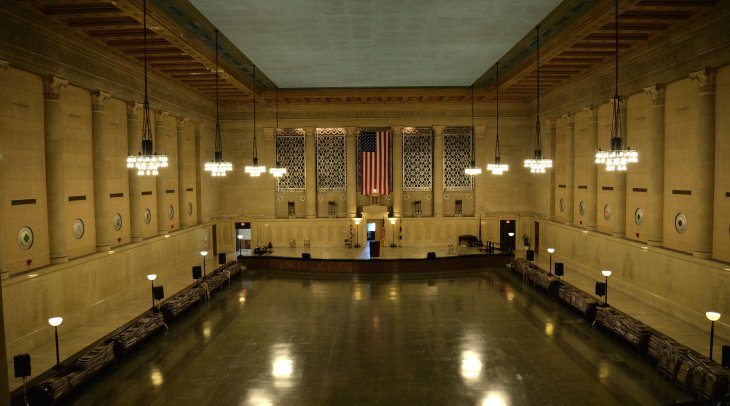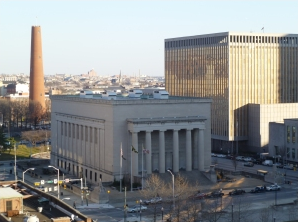History

“The War Memorial was designed as a ‘place of meeting for all veteran, patriotic and civic organizations, a depository for trophies of wars in which our country has engaged, and a tribute to those citizens of Maryland who gave their lives and services to their country in World War I.’
In 1919 the Governor of Maryland and the Mayor of Baltimore appointed a joint building commission. Subsequently they selected an architectural advisor and, through a nationwide architectural competition, a building design which fulfilled the purposes of the memorial. The winning design was that of Baltimore architect Lawrence Hall Fowler.
On November 22, 1921, ground was broken at the southeast corner of Lexington and Gay Streets by Ferdinand Foch, Marshall of France. The cornerstone was laid by Acting Secretary of War, Colonel Dwight F. Davis, the Governor of Maryland, Albert C. Ritchie, and the Mayor of Baltimore, William F. Broening on April 29, 1923. The War Memorial was dedicated on April 5, 1925. The War Memorial was constructed at a cost of $1,100,000.00, exclusive of the site. Both the state and city governments have always shared the expense of the building and its maintenance. On November 6, 1977, Mayor William Donald Schaefer rededicated the building as a memorial to the Marylanders who gave their lives in all of America's twentieth-century wars.
 The War Memorial and the Memorial Plaza cover two city blocks and face City Hall. The large white Neoclassical building with its six columns and broad steps houses a number of offices which serve as administrative headquarters for veterans of the armed forces. In addition, it houses an assembly room that is used by various civic and veteran groups for community meetings and social functions. On the second floor, there is a 1000-seat auditorium. The names of all 1,752 Marylanders who died during World War I are inscribed on the walls, and large shields bear the insignias of many military divisions.” [1] “Covering the west end of the interior balcony wall is a classical style mural by Baltimore-artist, R. McGill Mackall, depicting, ‘A Sacrifice to Patriotism.’ The high-ceiling interior is softened and embellished through the use of dark-red marble in the vestibule, Belgian block and marble in the main room and Italian Travertine marble floors throughout the building. The War Memorial building contributes to the Business and Government National Register Historic District.”[2]
The War Memorial and the Memorial Plaza cover two city blocks and face City Hall. The large white Neoclassical building with its six columns and broad steps houses a number of offices which serve as administrative headquarters for veterans of the armed forces. In addition, it houses an assembly room that is used by various civic and veteran groups for community meetings and social functions. On the second floor, there is a 1000-seat auditorium. The names of all 1,752 Marylanders who died during World War I are inscribed on the walls, and large shields bear the insignias of many military divisions.” [1] “Covering the west end of the interior balcony wall is a classical style mural by Baltimore-artist, R. McGill Mackall, depicting, ‘A Sacrifice to Patriotism.’ The high-ceiling interior is softened and embellished through the use of dark-red marble in the vestibule, Belgian block and marble in the main room and Italian Travertine marble floors throughout the building. The War Memorial building contributes to the Business and Government National Register Historic District.”[2]
 “Around the top of the building is inscribed the names of all the counties of Maryland and Baltimore City. On the terrace in front of the building on the west facade, are two sculptured sea horses, the work of Edmond R. Amateis of New York, which represent the "Might of America crossing the seas to aid our allies." Against one of these horses is carved the coat of arms of the State of Maryland surmounted by an osprey representing the Navy; and against the other, the coat of arms of the City of Baltimore, surmounted by an eagle representing the army.
“Around the top of the building is inscribed the names of all the counties of Maryland and Baltimore City. On the terrace in front of the building on the west facade, are two sculptured sea horses, the work of Edmond R. Amateis of New York, which represent the "Might of America crossing the seas to aid our allies." Against one of these horses is carved the coat of arms of the State of Maryland surmounted by an osprey representing the Navy; and against the other, the coat of arms of the City of Baltimore, surmounted by an eagle representing the army.